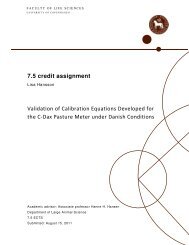Innovative Technology and Sustainable Development of Organic - 1.
Innovative Technology and Sustainable Development of Organic - 1.
Innovative Technology and Sustainable Development of Organic - 1.
Create successful ePaper yourself
Turn your PDF publications into a flip-book with our unique Google optimized e-Paper software.
3.2.9 Milk Quality Aspects<br />
Indicators selected to assess milk quality aspects related directly to the AMS technique (Meijering et<br />
al., 2004) or to grazing (Elgersma et al., 2004; Ellis et al., 2006). The concentration <strong>of</strong> free fatty acids<br />
(FFA) in milk is assumed to be influenced by milking frequency, milk flow per milking, storage time,<br />
pumping <strong>and</strong> mixing (especially <strong>of</strong> milk that is not cooled), <strong>and</strong> diet composition (Rasmussen et al.,<br />
2006). Large amounts <strong>of</strong> saturated lipids in the diet can result in large fat globules in the milk, which<br />
are susceptible to lipolysis <strong>and</strong> cause the breakdown <strong>of</strong> protected fat to free fatty acids. The FFA<br />
concentration in milk, measured in acid degree value (ADV in milli equivalents per litre [meq/l] <strong>of</strong><br />
milk), was therefore chosen as an indicator for milk quality. Data on FFA concentration in milk was<br />
acquired from a milk composition survey financed by the Danish Dairy Board (Rasmussen et al.,<br />
2006).<br />
Furthermore, insufficient hygiene using AMS might result in contamination by spores <strong>of</strong><br />
Clostridium tyrobutyricum. This bacterium can cause cheese to explode because <strong>of</strong> a fermentation<br />
process producing hydrogen <strong>and</strong> carbon dioxide. Spores are resistant to pasteurization <strong>and</strong> contaminate<br />
milk through contaminated roughage silage causing spores in manure, which in addition can infect<br />
teats. When washing <strong>of</strong> the udder is neglected before the milking process, this can cause high spore<br />
concentrations in the milk. The number <strong>of</strong> spores per litre <strong>of</strong> milk, therefore, was taken as an indicator<br />
<strong>of</strong> milk quality.<br />
Somatic cell count (SCC) indicates mastitis problems, as well as possible stress <strong>and</strong> is therefore<br />
used as an indicator in this study. Mastitis can be provoked by stress or neglected surveillance, which<br />
have both been suggested as possible problems with AMS use (Meijering et al., 2004). SCC counts<br />
leucocytes <strong>and</strong> cows’ own udder cells, which are in emulsion with the milk. The amount is correlated<br />
with infection (clinical <strong>and</strong> sub clinical) <strong>of</strong> the udder, which is usually mastitis. Both milk delivered<br />
<strong>and</strong> milk directly sampled from the cows was analyzed.<br />
3.2.10 Statistical Analysis<br />
Quantified SI <strong>of</strong> both farm groups were tested for normality, using the Anderson-Darling test, which is<br />
suitable for small sample sizes (n ≤ 25) (Anderson <strong>and</strong> Darling, 1952). Subsequently, SI were analyzed<br />
by single-factor ANOVA testing the variance <strong>and</strong> probability for significant differences. St<strong>and</strong>ard<br />
deviations were computed for each set <strong>of</strong> data registered for each SI. Only differences with a P value <strong>of</strong><br />




